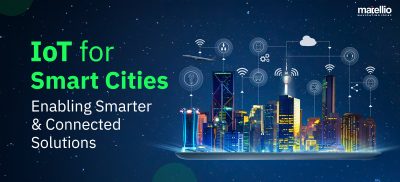
Are you an insurance company seeking digital transformation with capabilities like automated underwriting, fraud detection, customer analytics, and connected systems? Well, then, IoT in insurance is the solution for your business problems!
IoT (the Internet of Things) has transformed the world significantly through connected devices and sensors. As per McKinsey, by 2025, there will be 50 billion networked devices powered by IoT. And amongst all the various industries in which IoT has been transforming, the insurance sector remains the newest and leading.
But what facets of your business can be improved by IoT development services, what are the benefits, and what challenges do you have to resolve while implementing IoT in insurance? Let’s explore answers to all these questions!
Read More: Top Insurance Technology Trends in 2023
The Impact of IoT on Insurance
IoT in insurance has not remained a sci-fi term anymore. Instead, it has become the backbone of the organization to streamline complex and mundane tasks and bring new revenue-generating opportunities to the sector.
Whether we talk about enhancing customer interactions and cross-selling products/services, reducing costs through fraud prevention, or even offering digital ecosystems like connected health, smart housing and mobility, and commercial lines, the IoT insurance industry has come a long way.

As evident, the IoT insurance industry is growing rapidly and changing the present landscape. And why not?
IoT in insurance allows you to collect and analyze vast amounts of data from connected devices such as wearables, telematics, and smart home devices. This data can help you gain valuable insights into the behavior and habits of your target audience, allowing for personalized insurance policies based on individual risk profiles.
You can also spot possible hazards, stop losses, and provide timely and focused risk management solutions by utilizing real-time data. Not only that but by tracking and reporting on numerous metrics, IoT devices can even support better risk assessment and management.
For instance, telematics systems in cars can record driving habits and deliver precise information for risk assessment. By basing premiums on actual driving behavior, usage-based insurance policies encourage safe driving practices and lower insurance costs for policyholders.
From an investor’s perspective, the IoT insurance industry presents attractive opportunities for growth and innovation. In fact, companies such as Allianz have now started to leverage IoT development services to utilize the latest digital ecosystems like smart homes, connected health, and connected vehicles to generate new revenue models. With the increasing adoption of IoT devices and the technology’s potential to disrupt traditional insurance models, you can also expect significant returns on your investments in this sector.
Read More: Top 5 Digital Trends Transforming the Insurance Industry
IoT Insurance Benefits – How It Is Transforming the Industry
So, we explored the impact of IoT in insurance and the drastic market this trend has gained. But what is luring companies to invest in the IoT insurance industry? What benefits does IoT provide for the insurance sector? Let’s explore!
 Assess Risks More Precisely
Assess Risks More Precisely
The foremost benefit of implementing IoT in insurance is enhanced risk management and fraud detection capabilities. We all know that custom IoT solutions, with the help of sensors and data, offer accurate and real-time business insights. In such a situation, it becomes clear which operations are at risk or which claims are fraudulent. This proactive approach by IoT insurance solutions aids in reducing claims and minimizing damage for your company while leading to improved profitability.
 Streamlined Claims Processing
Streamlined Claims Processing
Another excellent benefit of adopting IoT for insurance is a faster and automated claim management system. Custom IoT solutions for the insurance industry enable you to process claims in a faster and more efficient manner. Connected devices based on IoT can automatically notify you and your managers about incidents, accelerating claims initiation and settlement. This reduces the time, effort, and resources required for claims management and enhances customer satisfaction.
 Lower Operational Cost
Lower Operational Cost
Every business adopts digital transformation services to lower operational costs and bring innovation to their business operations. Well, that’s what IoT in insurance does! When you leverage IoT insurance use cases, it lets you optimize your business operations and reduce costs. For instance, automated risk assessment and fraud detection help in more accurate underwriting, minimizing the chances of overpaying claims. Furthermore, IoT-driven monitoring and maintenance of insured assets prevent damage and reduce the frequency and severity of claims.
 Satisfied Customers and Better CX
Satisfied Customers and Better CX
Last but not least, IoT in insurance transforms the landscape by enabling personalized policies and value-added services. By leveraging data from connected devices, you can offer customized solutions, tailored recommendations, and proactive risk management advice to your customers. What it does is that it fosters better customer engagement, loyalty, and overall satisfaction. And Who doesn’t want happy customers? After all, they are the prime source of free marketing for your brand!
In short, there are countless benefits of IoT in insurance which have lured people into investing in this trending technology. That’s why leading brands like John Hancock and Vitality are the topmost adopters of IoT insurance solutions. So, what’s stopping you from becoming a part of this same league? Connect with us to get started with IoT solutions development for your insurance company!
IoT Insurance Use Cases – How to Leverage IoT for Insurance
So, till now, we explored the impact and benefits of implementing IoT in insurance. But how can you implement IoT enterprise solutions in your organization while gaining a competitive edge? In other words, what are the top IoT insurance use cases which can help you become a global brand in the insurance sector?
Well, as per the trusted sources, the main objective of today’s insurance companies is to implement the UN Sustainable Development Goals into their organization. These goals include promoting innovation and building future-ready policies, risk prevention, improving customer experiences, supporting sustainable and smart cities, offering affordable insurance coverage, and generating new business opportunities.

All these goals can only be covered by implementing IoT in insurance. Well, we are not saying this. In fact, the World Economic Forum, along with IoT Analytics, conducted an analysis that proved that 84% of IoT applications for the insurance sector could perfectly cater to all the UN SDGs.
Hence, as a leading IoT development service provider, we have listed the top IoT insurance use cases which you can leverage to join the league of successful insurance companies across the world.
Here are the areas where you can implement IoT development services for better growth and new opportunities:
Telematics for Commercial Auto Insurance
The foremost IoT insurance use case is the introduction of telematics sensors to streamline the commercial auto insurance aspect. IoT-enabled telematics devices installed in vehicles collect real-time data on driving behavior to offer usage-based insurance policies and tailor premiums based on individual driving habits.
Seems difficult to understand? Well, picture this – there are smart telematics devices in commercial vehicles. Now, these smart and connected devices will track real-time driving stuff like speed, how fast the customer hit the brakes, and what harsh driving conditions were. But how will it help you? Well, it’s like tailor-made insurance. Insurers use this data to create policies that match how you drive, so if your client is a careful driver, the coverage could cost less. Plus, it’s a win for safety, too – these smarter policies encourage better driving habits and cut down the chances of accidents.
Smart Home Devices for Personal Property and Casualty Insurance
Another exciting IoT insurance use case is smart home devices for property insurance. IoT devices, including smart security systems, smoke detectors, water leak sensors, and thermostats, can alert your clients of the risks involved in their homes. Intrigued?
They watch over their home 24/7 and ping them and you (insurance folks) if there’s any trouble. For instance, if there’s smoke in the living room or kitchen or a water leak in the basement, these IoT-based connected devices will keep everyone informed. So, what does that mean?
Well, it simply refers to less damage, fewer claims, and faster claim resolvent. It’s more like automating and streamlining property insurance smarter with IoT development services. Hence, this excellent IoT insurance use case can help prevent damage, reduce the number of claims, and enable timely response and mitigation of incidents.
Wearable Technology for Health and Life Insurance
Health and life insurance is one of the major facets of the insurance industry, which you can revolutionize via IoT development services. For instance, fitness bands and smartwatches could shape your client’s health insurance by gathering info about how they live, what fitness regime they follow, and what their eating habits are. Using this data, they can create personalized health insurance plans that match their lifestyle, which eventually results in fewer claims. How? Well, the healthy choices of your customers could lead to better insurance deals. By encouraging healthy habits and keeping tabs on your well-being, IoT in insurance makes sure your customers are on the right track for good health.
Fitness trackers, smartwatches, and health monitoring devices allow you to collect data on policyholders’ health and lifestyle habits. This data can contribute to personalized health insurance plans, promote healthy habits, and encourage preventive care, ultimately leading to improved underwriting accuracy and better health outcomes.
Drones for Risk Assessment and Claims Processing
Yet another promising IoT insurance use case is the adoption of drones for risk assessment and claims processing. Yep, those flying machines with awesome cameras. Insurers are today employing drones equipped with high-resolution cameras to assess risks and inspect hard-to-reach or hazardous areas.
Drones take super clear pictures and videos that help the experts figure things out. These machines help you in risk evaluations, damage assessments, and insurance claim processing, improving efficiency and reducing costs. Plus, it saves money too. So, imagine drones as your high-tech helpers in the insurance world, thanks to IoT.
Industrial IoT Development Services for Commercial Property and Liability Insurance
Have you ever heard of Industrial IoT services? Well, they are quite popular for the industries that are planning to step into Industry 5.0. Industrial IoT or IIoT services are helpful for industries like logistics, supply chain, aviation, and manufacturing as it helps them keep an eye on big machines and tricky spots. And guess what – this is a leading IoT insurance use case.
Today, many insurance companies are using IoT development services to leverage smart data from these setups for creating special insurance plans for stuff like property and risks. It’s all about getting a better handle on things and keeping everyone safe.
This IoT insurance use case helps you in the efficient handling of risks, makes insurance fit like a glove, and stops accidents before they happen. These IIoT devices monitor equipment performance, detect maintenance issues, and ensure workplace safety. Hence, this data can easily be leveraged by your team to offer custom policies to your clients.
Crop Monitoring for Agriculture Insurance
Last but not least, a fascinating use case of IoT in insurance is the use of crop monitoring devices for agriculture insurance. IoT in agriculture insurance is helping farmers and insurers streamline many facets of their operations. For instance, smart gadgets, with a dash of IoT magic, check stuff like crop health, soil conditions, weather, and when those plants could use a drink. Now, here’s the magic part. Insurance folks like you can use this crucial info to do something awesome.
So, if there’s bad weather or low yields, farmers have a backup. It’s like a personal insurance plan for each farmer. All this smartness? It’s thanks to IoT in insurance, making farming safer and cooler than ever before. This data can also help you assess risks associated with crop farming and offer customized insurance policies covering yield losses, weather-related damages, and other agricultural risks.
Top Challenges of IoT in Insurance
Like a coin with two sides, the IoT insurance sector has its pros and cons. On the bright side, it offers exciting opportunities for better customer interactions and making more money. But like with anything new, there are challenges when it comes to using IoT in insurance. So, what are these challenges? And how can we overcome them? Let’s find out together!
Changes in the Existing Insurance Models
The foremost challenge of implementing IoT in insurance is the disruption in the existing models. IoT presents a dilemma for insurance executives. On one side, it offers benefits like risk reduction and lower claims, but this could lead to lower premiums and shrinking revenue over time. Furthermore, you may also face new competition from auto manufacturers, home security companies, and digital giants.
Not to mention, IoT promises lower premiums for those who drive safely or follow healthy habits, but if it doesn’t influence behavior across the population, it could lead to heavy penalties. That eventually results in government hindrances as people will have to pay heavy premiums, and this will hinder the growth of IoT insurance products.
Slow Pace in Health and Life Insurance
Another major challenge of the IoT insurance sector is the slow pace in the health and life insurance arena. That’s because the health and life space deals with multiple compliance, regulations, and people. To execute at scale, the insurers have to deal with multiple regulatory authorities, which is a tedious and time-consuming process.
Data Management and Ownership
Another major challenge of implementing IoT in insurance is the data management and ownership task. We all know that IoT development services work majorly on the data, and the IoT insurance industry is no exception! Whether the data is related to claims and policies or business insights and customer analytics, it needs efficient handling to make smart moves.
However, tackling this expansive data overload from IoT isn’t a piece of cake. It needs a solid plan for managing all this info. Furthermore, the ownership of this data is also a critical aspect. All that and the various laws related to data protection make IoT in insurance a bit of a skeptical trend.
To overcome all these issues, you will need an expert who understands the complex structure of the IoT landscape and has access to the best IoT consulting and development services tailored to the insurance industry’s needs.
That’s Where Matellio Steps into Play!
As a leading software engineering company with a knack for providing top-rated IoT consulting services to companies globally, we have the expertise you need to seamlessly implement IoT in your insurance company. Whether you seek to consult to discover the best use case of IoT in insurance or you need to hire IoT developers to complete your project, we can help you with everything.
We have partnered with several companies and helped them with our business focused IoT development services to streamline their operations and open new doors of opportunities for them, and we can do the same for you. And it’s easy to connect with us and get started on your project. You simply have to fill out our form, and our experts will handle everything thereafter.
So, leverage our free 30-minute expert consultation service and explore the best IoT development services for your insurance agency.

 Assess Risks More Precisely
Assess Risks More Precisely Streamlined Claims Processing
Streamlined Claims Processing Lower Operational Cost
Lower Operational Cost Satisfied Customers and Better CX
Satisfied Customers and Better CX



